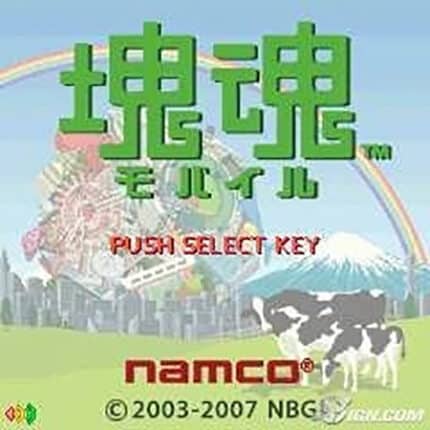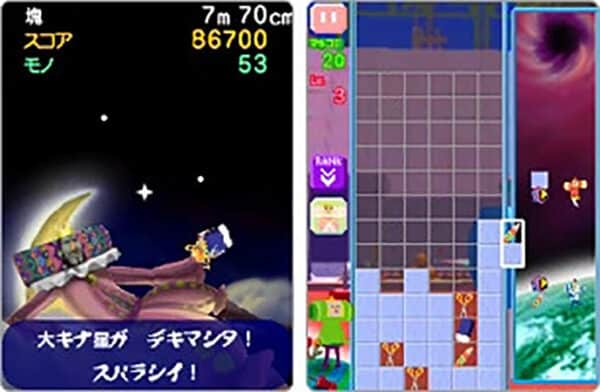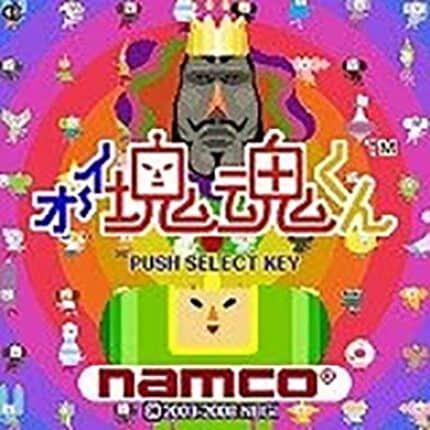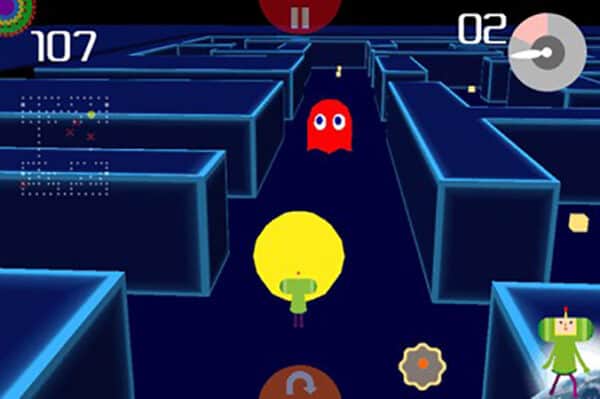Like many of the best Japanese games, compiling a list of all Katamari games in order can prove challenging due to region-locked exclusives that were never released outside of Japan.
As such, there’s very little information available for certain Katamari games, particularly those that came to mobile and have since been delisted.
However, with a bit of patience and heavy research, we’ve tracked down screenshots and info for each game in the series to bring you this list of all Katamari games in order of release date.
So, without much further ado, let’s get rolling!
Table of ContentsShow

Katamari Damacy
Release Date: March 18, 2004
Platform: PS2
Created by Keita Takahashi and developed and published by Namco, the original Katamari Damacy is a PS2-exclusive puzzle-action game that kicked off the entire series.
While the story is quite bizarre and convoluted at times, the basic premise sees your character the Prince, helping his father the King of All Cosmos recreate constellations in the sky.
How exactly? By rolling up various objects throughout the world into giant balls of mass called Katamari.
The game’s quirky premise and even more unique gameplay led to moderate success in Japan as well as in North America, where it was dubbed a “sleeper hit.”

We Love Katamari
Release Date: July 6, 2005
Platform: PS2
About a year later, Katamari Damacy was followed up by We Love Katamari, another PS2-exclusive title directed by Keita Takahashi, although begrudgingly so.
The sequel maintains the stylized visuals, quirky storytelling, and distinct puzzle-action gameplay of the original while adding multiplayer modes and additional level objectives.
In terms of narrative, We Love Katamari is very self-referential, with the King of All Cosmos encouraging the Prince and his cousins to roll up Katamari to satisfy fans of the first game.
Following its release, the game was very well-received and is widely considered the overall best entry in the Katamari series.

Me & My Katamari
Release Date: December 22, 2005
Platform: PSP
Releasing the same year as We Love Katamari, Me & My Katamari is the first PSP-exclusive title and the first entry in the series created without the involvement of Keita Takahashi.
Having no interest in turning the original concept into an ongoing series, Takahashi found himself at odds with Namco executives who were willing to move forward with or without him.
The story sees the Royal Family taking a much-needed break from celestial construction by traveling to Earth for a tropical summer vacation.
Despite Takahashi’s absence during the game’s development, Me & My Katamari still received positive reviews and is regarded as a fun handheld adaptation of the series’ gameplay.

Katamari Damacy Mobile
Release Date: June 1, 2007
Platform: Docomo’s 904i
Roughly two years later, the first mobile Katamari game, aptly named Katamari Damacy Mobile, was released for the Mitsubishi P904i line of phones in Japan.
Considered a spin-off, it implemented unique controls that leveraged GestureTek EyeMobile software allowing for tilt and vibration detection using the phone’s built-in camera.
As such, players can move the Katamari ball forward, backward, and left and right by tilting the phone at different angles or opt to use traditional controls instead.
This software was particularly finicky on P904i phones, resulting in imprecise controls and an overall bad gameplay experience that led to negative coverage for Katamari Damacy Mobile.

Beautiful Katamari
Release Date: October 16, 2007
Platform: Xbox 360
Dropping the same year as Katamari Damacy Mobile, Beautiful Katamari is a full-fledged console release that switched platforms, going from PlayStation to Xbox exclusively.
In it, the King of All Cosmos, his Queen, and the Prince are playing tennis when a powerful serve rips through the universe’s fabric, after which the Prince sets out to recreate lost planets and stars.
While the gameplay was largely the same, Beautiful Katamari placed a bigger emphasis on mission objectives, with players encouraged to build Katamari using specific types of items.
Ultimately, the game did not review as well as its predecessors, receiving mixed or average scores from most gaming outlets at the time.

Katamari Damacy-kun
Release Date: November 1, 2007
Platform: Mobile
Considered lost media these days, Katamari Damacy-kun is another Japan-exclusive mobile Katamari game that was released in 2007.
Not much is known about the story or gameplay, other than the fact it’s played on a 2D plane with side-scrolling controls.
If you would like to take a look for yourself, we encourage you to check out the website Windream, which has the only known screenshots of Katamari Damacy-kun.

Rolling with Katamari
Release Date: November 1, 2008
Platform: Mobile
Yet another relatively obscure entry in the Katamari series, Rolling with Katamari was released for mobile devices in 2008.
Much like Katamari Damacy-kun, it centers on retro-inspired 2D gameplay in which players roll up objects into Katamari.
To account for smartphone touchscreens, the game relies on touch-based controls in which the player must drag their finger across environments to guide the Prince.

I Love Katamari
Release Date: December 14, 2008
Platforms: iOS, Android, Windows Phone
Next up on our list of all Katamari games in order, we have I Love Katamari, a mobile-exclusive title released a month after Rolling with Katamari.
In it, we see the King of All Cosmos suffering from amnesia and urging the Prince to roll up Katamari so that he can pick up special objects to help the King regain his memory.
Gameplay is practically identical to the original Katamari Damacy with consideration for touchscreen controls and tilt functionality.
Although I Love Katamari has been praised for its visuals, the overall consensus is that it drops the ball in several areas, particularly performance and controls.

Korogashi Puzzle Katamari Damacy
Release Date: March 25, 2009
Platform: Nintendo DSi
Breaking from the series’ core format, Korogashi Puzzle Katamari Damacy is a falling block puzzle game and the first Katamari game to appear on a Nintendo platform.
The gameplay is very reminiscent of games like Tetris as well as Pac-Attack, another puzzle game created by Namco in which players stack items up.
Unique to Korogashi Puzzle Katamari Damacy is the ability to drop a Katamari ball on stacks of items to roll them up before being swept away.

Katamari Forever
Release Date: July 23, 2009
Platform: PS3
Known in Japan as Katamari Damacy Tribute, Katamari Forever sees the series returning to the PlayStation platform as a console exclusive.
Combining elements of previous games, it sees the Prince helping the King recover from amnesia while a robotic doppelganger dubbed RoboKing, goes on a rampage destroying all the stars.
Both old and new levels are introduced alongside the “Prince Hop,” a new ability that lets the Prince hop into the air, and “King Shock,” which sucks up nearby objects like a magnet.
Upon release, Katamari Forever was met with positive reviews only slightly lower on average than previous mainline games in the series.

Oi Katamari Damacy-kun
Release Date: October 28, 2009
Platform: Mobile
Released in 2009 exclusively for mobile devices, Oi Katamari Damacy-kun is a follow-up to Katamari Damacy-kun.
Similar to its predecessor, little is known about its story and gameplay aside from a handful of screenshots on Windream.

Katamari Amore
Release Date: September 29, 2011
Platform: iOS
The next mobile Katamari game was released two years later exclusively for iPhones under the title Katamari Amore.
The general premise sees the King discovering a book referencing rare and beautiful objects that can be found scattered across the world.
This leads him to assign the Prince the monumental task of seeking out these elusive treasures and rolling them into Katamari balls to bring back to the King.
Unfortunately, Katamari Amore was met with mixed to negative reviews as critics took issue with its controls and freemium pricing model.

Katamari Damacy Mobile+
Release Date: November 17, 2011
Platform: Android
Later that same year, an Android port of the original Katamari Damacy was released in Japan as Katamari Damacy Mobile+.
While it’s unclear what changes were made, if any, to the original game, one can surmise that gameplay and controls had to be adapted for Android devices.

Touch My Katamari
Release Date: December 17, 2011
Platform: PS Vita
Released in Japan as Katamari Damacy No-Vita, Touch My Katamari is another PlayStation handheld-exclusive entry in the series.
Available for the PS Vita, this iteration features new gameplay mechanics designed to take advantage of the handheld’s touchscreen, back touch panel, etc.
Doing so would allow the player to squash and stretch their Katamari while carrying out missions for a now-depressed King of All Cosmos.
While Touch My Katamari made several strides to appeal to newcomers, much of its content was recycled from previous games and, somewhat expectedly, met with a mixed reception.

Katamari Damacy Mobile 2
Release Date: March 8, 2012
Platform: iOS
Moving along with our list of all Katamari games in order, Katamari Damacy Mobile 2 made its way onto the Japanese iOS app store in March 2012.
Billed as a sequel to the first Katamari Damacy Mobile title, it offers similar gameplay further complemented by a host of crossover content with Galaga and Pac-Man.
Beyond that, details are fairly scarce, with the only known screenshots appearing on the website 4gamer.

Tap My Katamari
Release Date: January 4, 2016
Platforms: iOS, Android
Another mobile entry that strays from the series’ core design, Tap My Katamari is an idle game where players tap the screen to roll Katamari.
A new object would occasionally appear for the player to roll up, similar to other idle-clicker games like Cookie Clicker.

Amazing Katamari Damacy
Release Date: December 5, 2017
Platforms: iOS, Android
Amazing Katamari is another spin-off conceived as an endless runner game wherein players traverse lanes to build up Katamari.
Over time, the Katamari would grow large, allowing the player to purchase upgrades for the Prince’s cousins and rockets.

Katamari Damacy Reroll
Release Date: December 7, 2018
Platforms: Windows, Switch, PS4, Xbox One
Serving as an HD remaster of the first game in the series, Katamari Damacy Reroll features noticeably better graphics and other visual changes from the original.
Additionally, controls were made similar to We Love Katamari and later entries, with the Switch version including support for the system’s gyro controls.
Katamari Damacy Reroll was well-received by critics and even nominated for the Freedom Tower Award for “Best Remake” at the 2020 New York Game Awards.

We Love Katamari Reroll + Royal Reverie
Release Date: June 2, 2023
Platforms: Windows, PS5, PS4, Xbox Series X/S, Xbox One, Switch
Reroll’s success no doubt played a part in Namco’s decision to greenlight an HD remaster of the second game in the series with We Love Katamari Reroll + Royal Reverie.
Much like its predecessor, this version includes redesigned graphics in addition to revamped UI that makes it easier to play and a new in-game selfie camera mode.
Lastly, this remaster features additional content in the form of Royal Reverie, a set of new challenges that follow the King of All Cosmos during his youthful years.




